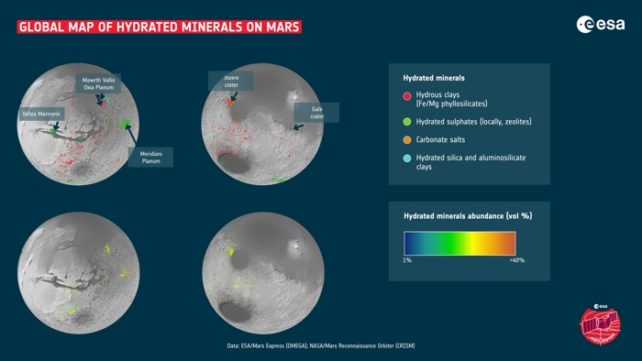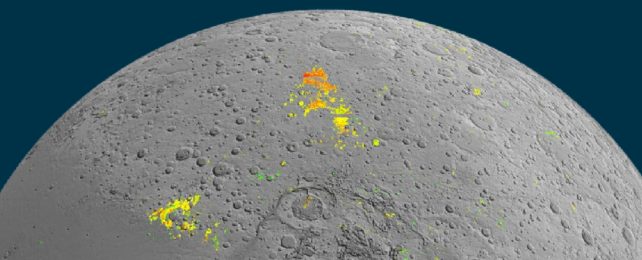A new map, years in the making, reveals where we can find ancient traces of water on Mars.
Using data collected over the past decade by ESA's Mars Express and NASA's Mars Reconnaissance Orbiter, both currently in orbit around the red planet, scientists have created the most comprehensive map yet of specific Martian mineral deposits.
The deposits are aqueous minerals – those that have been altered by the presence of water, like clays.
We know there are clays on Mars; we've even seen some up close, or as close as we can, via the Curiosity rover. However, a broader map of where they can be found gives us a more comprehensive picture of the water history of Mars and will help plan future exploration of the now dry and dusty world.
And, contrary to expectations, the map shows that wherever we go on Mars, we're bound to find something interesting.

Before the survey started, there were around a thousand known aqueous mineral deposits on Mars. The new work, led by planetary scientist John Carter (um, this is spooky) of the University of Paris-Saclay and Aix Marseille University in France, has identified rather significantly more.
The new map shows that there are hundreds of thousands of aqueous mineral deposits on Mars, at least – particularly in some of the oldest parts of the planet's surface.
"I think we have collectively oversimplified Mars," Carter says.
"This work has now established that when you are studying the ancient terrains in detail, not seeing these minerals is actually the oddity."

Studying these minerals in greater detail can reveal how much water has, historically, been present on Mars.
For example, here on Earth, clays are formed when water and another mineral interact, resulting in a different mineral.
Vermiculites, smectites and chlorites form when water interacts with iron and/or magnesium. Al-smectites and kaolins are formed from water interactions with aluminum.
But the amount of water, too, plays a role.
The more water, the more altered the final mineral. So, scientists can look at different mineral deposits and make an estimate about how much water was present at the time the mineral formed.
The work of Carter and his colleagues has revealed the presence of the minerals mentioned above as well as sulfate and carbonate salts through spectrometric data. That's the measurement of light reflected by an object; both orbiters are equipped with spectrometers, the data from which complement each other on the mineralogy of the Martian surface.
The resultant map suggests that there is not a lot of Mars that hasn't been altered by water at some point in its history. The planet may be a pretty dry place now, but the evidence suggests that it has historically been no stranger to sogginess.
It also suggests that the previous reconstruction of its water history – that water formed the clays, then the salts came along as the waters dried up – might be a little too simplistic.
Some of the salts in the new map seem to be older than some of the clays, and, in some regions, the two are mixed in a way that suggests they may be contemporaneous.
Unraveling the implications of these findings is going to take a significant amount of analysis.
"The evolution from lots of water to no water is not as clear cut as we thought, the water didn't just stop overnight. We see a huge diversity of geological contexts, so that no one process or simple timeline can explain the evolution of the mineralogy of Mars," Carter explains.
"That's the first result of our study. The second is that if you exclude life processes on Earth, Mars exhibits a diversity of mineralogy in geological settings just as Earth does."
Another question that remains is whether water was persistent or episodic. Was it there for a long period of time, or did it periodically disappear and reappear?
Not much can be gleaned simply from a map of where the minerals are… but, in another paper, a team led by planetary scientist Lucie Riu, then at JAXA and now at ESA, quantified the abundances of aqueous minerals as seen in the global map.
"If we know where, and in which percentage each mineral is present, it gives us a better idea of how those minerals could have been formed," Riu explains.
Together, the two papers constitute important groundwork that needed to be established before answering these questions.
And, perhaps, identifying the most interesting spots to send future missions, either crewed or uncrewed, in the quest to understand how Mars became a dry world – which, in turn, might have some answers about how Earth didn't.
The two papers have been published in Icarus. They can be found here and here.
